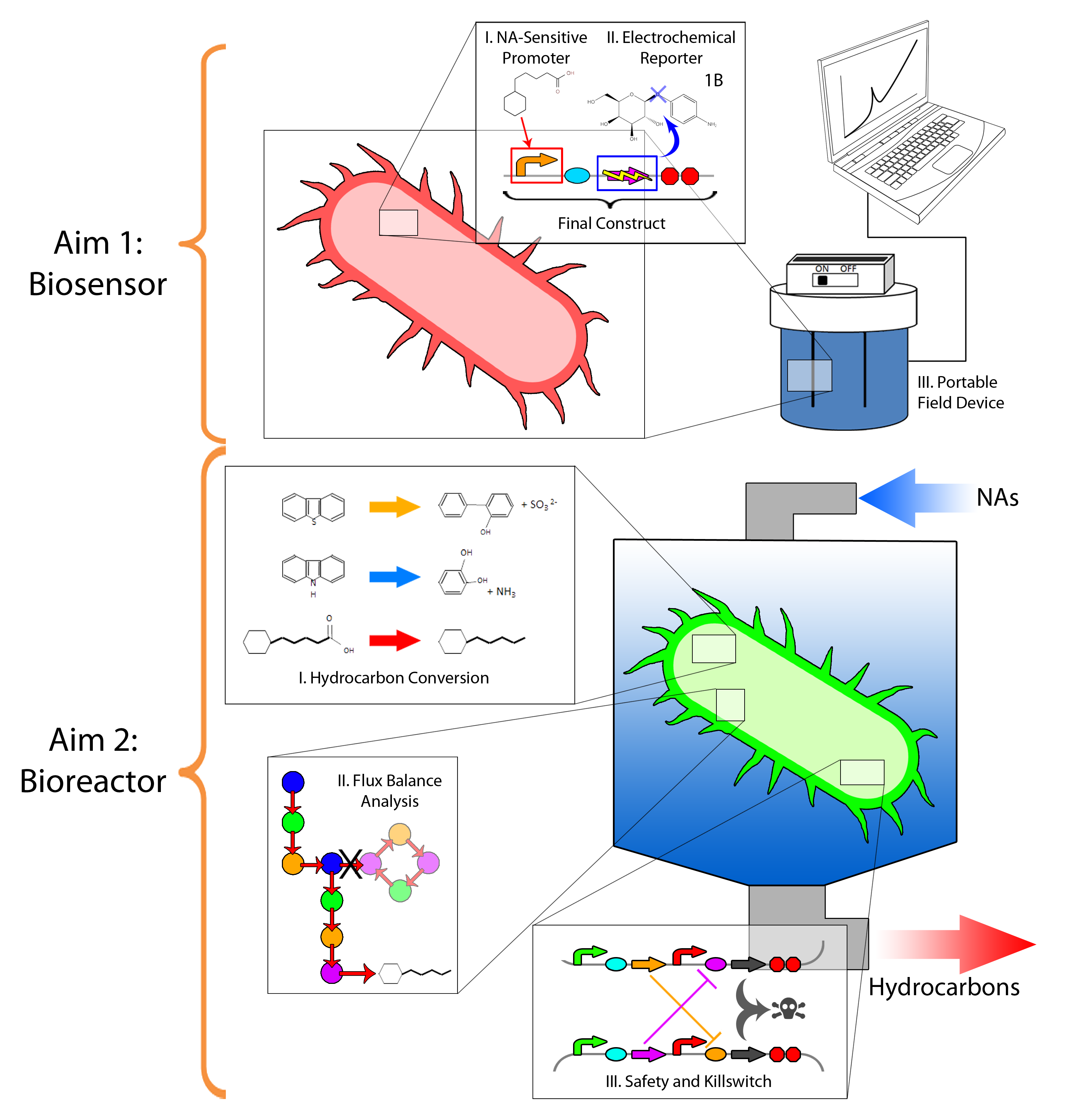Team:Calgary/Project/DataPage
From 2012.igem.org
Rpgguardian (Talk | contribs) |
Rpgguardian (Talk | contribs) |
||
| Line 11: | Line 11: | ||
<p>Rather than just sensing toxins in the tailings ponds, our major objective were to detoxify the tailings through the reduction of sulfur, nitrogen, catechol, and naphthenic acids from the tailing ponds. This was accomplished using native pathways found in various organisms. An added benefit to our system is that the removal of carboxylic acid groups from naphthenic acids results in the production of hydrocarbons. Purification of these hydrocarbons would contribute to an added economic and industrial benefit.</p> | <p>Rather than just sensing toxins in the tailings ponds, our major objective were to detoxify the tailings through the reduction of sulfur, nitrogen, catechol, and naphthenic acids from the tailing ponds. This was accomplished using native pathways found in various organisms. An added benefit to our system is that the removal of carboxylic acid groups from naphthenic acids results in the production of hydrocarbons. Purification of these hydrocarbons would contribute to an added economic and industrial benefit.</p> | ||
| - | </html>[[File:Calgary2012_OSLI_Graphical_Abstract_V3.4.png|thumb|800px|center| | + | </html>[[File:Calgary2012_OSLI_Graphical_Abstract_V3.4.png|thumb|800px|center|]]<html> |
| + | |||
| + | <h2>Parts Submitted To The Registry</h2> | ||
| + | |||
| + | <p><b>BBa_K902001</b> (Constitutive uidA Generator), <b>BBa_K902005</b> (Constitutive bglX Generator) Two new enzymes were submitted to the registry for the hydrolysis of two sugar conjugated electroactive compounds for the detection of multiple compounds with a single electrode. These enzymes were characterized to be able to catalyze their respective reactions and the detection of their products electrochemically. | ||
| + | |||
| + | <h2>Data From Characterized Parts Already In the Registry</h2> | ||
| + | |||
| + | <h2>Additional Work and Characterizations </h2> | ||
Revision as of 01:51, 1 October 2012


Hello! iGEM Calgary's wiki functions best with Javascript enabled, especially for mobile devices. We recommend that you enable Javascript on your device for the best wiki-viewing experience. Thanks!
Data Page
Overview:
Detect and Destroy
The Calgary team has developed a duel system for the detection of toxic components in tailing ponds as well as the remediation of these compounds. Tailing ponds are large lakes of waste products produced from the extraction of bitumen in the oilsands. Our biosensor involved the identification of a toxin promoter through a transposon screen. An electrochemical detector was implemented with a multiple output system allowing for the detection of multiple compounds simultaneously. This promoter/detector system was then complimented with the production of a biosensor system which we designed and implemented.
Rather than just sensing toxins in the tailings ponds, our major objective were to detoxify the tailings through the reduction of sulfur, nitrogen, catechol, and naphthenic acids from the tailing ponds. This was accomplished using native pathways found in various organisms. An added benefit to our system is that the removal of carboxylic acid groups from naphthenic acids results in the production of hydrocarbons. Purification of these hydrocarbons would contribute to an added economic and industrial benefit.
Parts Submitted To The Registry
BBa_K902001 (Constitutive uidA Generator), BBa_K902005 (Constitutive bglX Generator) Two new enzymes were submitted to the registry for the hydrolysis of two sugar conjugated electroactive compounds for the detection of multiple compounds with a single electrode. These enzymes were characterized to be able to catalyze their respective reactions and the detection of their products electrochemically.
Data From Characterized Parts Already In the Registry
Additional Work and Characterizations
 "
"
